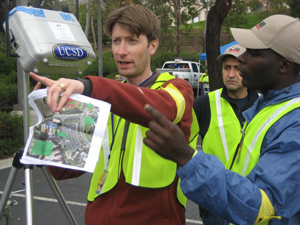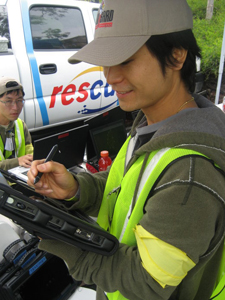WIISARD-SAGE Team Tests Improved Computing, Communication Technologies at Disaster Drill
By Tiffany Marie Fox, (858) 246-0353, tfox@ucsd.edu
San Diego, Calif., July 12, 2010 — With all the high-tech gadgetry at their disposal during a recent disaster drill, researchers from the University of California, San Diego, didn't expect that something as benign as safety masks would be problematic.
|
But that's exactly what happened at the "Golden Guardian" emergency preparedness exercise, which took place in late May on the California State University, San Marcos, campus and brought together rescue personnel from across San Diego County. Some of those so-called first responders — sent in to deal with a mock shooting and 'dirty bomb' — were provided with touchscreen-equipped patient scanning devices developed by researchers from the UC San Diego division of the California Institute for Telecommunications and Information Technology (Calit2). The phones were designed to improve communication and decision-making after a disaster, even when the local communications infrastructure is down.
"The masks the rescue personnel wear were a surprise," said Calit2's William Griswold, principal investigator for the Wireless Internet Information System for Medical Response in Disasters and Self-scaling Architecture for Group and Enterprise Computing project (also known as WIISARD-SAGE). "They do things like fog up, and prevent the providers from wearing eye glasses" and seeing the touchscreens properly.
The bulky gloves worn by firefighters, S.W.A.T. team members and other first responders also made entering information onto the touchscreens nearly impossible. One responder was spotted digging for a pen so he could use it to push the buttons on the screen.
"And that's problematic in a ‘hot zone,’ where there are so many time pressures," added Griswold.
|
For the WIISARD-SAGE team, determining these gaps in technological performance was the point of the drill. The project is focused on improving collaborative computing in disaster scenarios, where humans must rely primarily on mobile devices and ad-hoc networks to communicate with one another, track mass casualties and provide medical care. Drills like this one allow the researchers to measure the success of new approaches, including network and application performance, speed of information transmission and the effects on clinical work flow.
Griswold said that the UCSD researchers, who hail from the fields of electrical engineering, computer science, cognitive science and emergency medicine, are just beginning to analyze the many gigabytes of data — probably terabytes — that they captured while at the drill.
The large-scale disaster drill was held under the auspices of the federally funded San Diego Regional Metropolitan Medical Strike Team (MMST). MMST is comprised of various police departments, fire departments, hazmat, bomb squads and S.W.A.T. teams throughout San Diego County and was created to coordinate and enhance care of mass casualties in a terrorist attack or natural disaster.
Some of MMST first responders — as well as some of the so-called 'patients' at the drill — served as guinea pigs for the WIISARD-SAGE researchers, who tracked their movement around the disaster site. To do this, the researchers outfitted about 30 patients with business-card size radio frequency identification (RFID) tags, which they wore on their person. The MMST responders were themselves geo-located via GPS. Whenever a responder scanned a patient's RFID tag with hand-held short-field coupling device (similar in frequency to an electric toothbrush), the patient's record was updated with the responder's current location and the time. The researchers also calculated location based on trilateration and saved the data for later analysis.
Explained Griswold: "The movements and relative locations of responders impacts the types of ad hoc communications networks — networks that don't depend on deployed infrastructure — that you can deploy." Ad-hoc networks such as the Calit2-designed portable CalMesh network (which creates a wireless bubble of network and Internet activity) are crucial in times of disaster because cell phone towers or other linchpins of communications infrastructure might be damaged.
|
Tracking the movements of responders also helps prevent them (in the case of a dirty bomb) from leaving a potentially radioactive 'hot zone' before they've been decontaminated. In addition, it allows those coordinating response efforts to know how much time emergency personnel spend attending to each patient, which is important for resource allocation.
"It tells us when certain policemen or paramedics have seen enough in the hot zone and should rest," added Calit2 Principal Development Engineer Don Kimball. "The RFID tags also let us correlate what their status was when they left the hot zone, what their status is later on."
During the drill, an additional 30 patients wore long-range RFID tags, which were detected by stationary far-field coupling devices (similar to Bluetooth technology) from a distance of 1 to 10 meters. A "rover" from the WIISARD-SAGE team also employed a portable long-range device to prevent coverage holes — an essential step, it turns out, because of the nature of the ad-hoc network, which required signals to 'hop' from the RFID tags to the coupling devices to a nearby PC, and from the PC to the CalMesh nodes and onto a server (in a real disaster scenario, the servers would be located in hospitals).
"The rover turned out to be quite important," remarked Kimball, "because there was so much chatty traffic (or electromagnetic noise) from all the emergency vehicles in the area, which would cause intermittent reads and network timeouts. Those timeouts would cause us to miss several seconds worth of data being scanned. We combated that by going to 'sneakernet mode' by way of the rover, who collected the data and would run over to the server and deposit it via memory stick onto a flash drive, the old-fashioned way."
|
But even the "old-fashioned way" in this instance was superior to the current method for tracking disaster victims via paper barcodes.
"Paper tags get damp and muddy and don't read well," noted Kimball. "RFID tags can get muddy, wet and covered in blood, and you can still read them. The hope is that one day this technology will replace those paper tags."
Kimball says the next step for his team of researchers is to determine the best way to deliver the data to hospitals, which in a chaotic disaster situation, might not know when to expect new information.
"In these scenarios, responders will typically be sending very little data, but often in separate pieces," explained Kimball. "We need to determine a method that will ensure that the hospitals know when they haven't received all the data. There's an element of surprise associated with it." One method might be to replicate the system Bit Torrent uses, which alerts the user when part of the data is missing. Another option might be to take advantage of redundancy and have the responders send batches of information that contain half new data and half old data so that nothing is lost.
|
Also conducting research at the drill were researchers from UC San Diego's cognitive science department, led by UCSD Medical Center Assistant Clinical Professor and WIISARD-SAGE co-investigator Colleen Buono. The cog-sci researchers videotaped the disaster scenario as it unfolded to monitor the WIISARD-SAGE tracking system to see how it compared, on a human level, with the former paper tracking system.
"When introducing WIISARD, we knew there was a risk that some of the vital conversations that normally take place between responders no longer would, and consequently decision-making might deteriorate," the researchers noted in a paper on "The Cognitive Advantages of WIISARD. “For instance, face-to-face interaction might prove essential for optimal decision-making.
"On the basis of initial observations at drills," the paper continued, "we observed that paper encourages silos of information. The officers responsible for Treatment, Transport, and Medcom are each responsible for their own basket of information, and unless they meet face-to-face, they cannot share that information adequately any other way than by (short-wave) radio which is a thin and potentially fallible medium of communication."
|
Although the cog-sci team is still analyzing the data collected from the disaster drill, they hypothesize that the WIISARD-SAGE technologies will improve situation awareness, or how much people know about any given situation, by "breaking the silos at the officer level and, to a lesser degree, at the first responder level because responders in different roles can see each other’s information."
For their part, many of the emergency responders who used the WIISARD-SAGE technology during the drill said that once the kinks are worked out, the technology could provide an unobtrusive way to do their jobs more safely and efficiently. Mike Lopez, CFD battalion chief and a S.W.A.T. medic, said he could see the benefits of providing an RFID tag to all public safety personnel the moment they are hired.
"They could carry it around as an I.D.," he said, which could potentially allow for tracking at all times.
"I can only imagine this technology is going to help," added Richard Vance, fire captain of the Carlsbad Fire Department (CFD) and a S.W.A.T. medic. "Accountability is always a challenge. Any tool we have to improve accountability is always welcome.”
Media Contacts
Tiffany Marie Fox, (858) 246-0353, tfox@ucsd.edu
Related Links


.jpg)
.jpg)
.jpg)


.jpg)